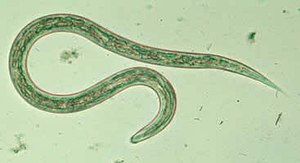Ancylostoma duodenale
| Ancylostoma duodenale | ||||||||||||
|---|---|---|---|---|---|---|---|---|---|---|---|---|
 Freilebende Larve von Ancylostoma duodenale | ||||||||||||
| Systematik | ||||||||||||
| ||||||||||||
| Wissenschaftlicher Name | ||||||||||||
| Ancylostoma duodenale | ||||||||||||
| (Dubini, 1843) |
Ancylostoma duodenale (unspezifisch Grubenwurm[1] und Hakenwurm[2]) ist eine der beiden für den Menschen pathogenen Hakenwürmer-Arten, die zu den Fadenwürmern gehören.
Der 8 bis 12 mm lange, gelblich-weiße Schlauchwurm lebt bei infizierten Menschen im Dünndarm.[1]
Die Art tritt in Südeuropa, Nordafrika, Indien, China, Südostasien sowie an gewissen Orten des amerikanischen Kontinents auf. Oft kommt er in Bergwerken vor, da er dort bezüglich Feuchtigkeit und Temperatur ideale Bedingungen vorfindet. Im Ruhrgebiet wurde der Hakenwurm wohl Ende des 19. Jahrhunderts aus südlichen Breiten eingeschleppt.[3] Die Übertragung geschieht durch Hautkontakt mit Boden, der Larven enthält. Diese Erkenntnisse wurden insbesondere in den 1880er-Jahren gewonnen, nachdem unter den Arbeitern des Gotthardtunnels in der Schweiz eine Ankylostomiasis-Epidemie ausgebrochen war.[4][5][6]
In der Pflanzenheilkunde wurde ein Extrakt des Wurmfarns Filix mas zur Therapie angewandt.[7]
Quellen
Weblinks
- Ancylostoma duodenale, Animal Diversity Web
- Hookworm; Ancylostoma duodenale and Necator americanus
- Ancylostoma duodenale auf plpnemweb.ucdavis.edu
Einzelnachweise
- ↑ a b BAuA: Merkblatt zur BK Nr. 3103: Wurmkrankheit der Bergleute, verursacht durch Ankylostoma duodenale oder Strongyloides stercoralis
- ↑ Hans Adolf Kühn: Rundwürmer (Nemathelminthes). In: Ludwig Heilmeyer (Hrsg.): Lehrbuch der Inneren Medizin. Springer-Verlag, Berlin/Göttingen/Heidelberg 1955; 2. Auflage ebenda 1961, S. 837–840, hier: S. 840: Ankylostoma duodenale (Hakenwurm, Grubenwurm).
- ↑ Hans Adolf Kühn: Ankylostoma duodenale (Hakenwurm, Grubenwurm). In: Ludwig Heilmeyer (Hrsg.): Lehrbuch der Inneren Medizin. Springer-Verlag, Berlin/Göttingen/Heidelberg 1955; 2. Auflage ebenda 1961, S. S. 840.
- ↑ E. Bugnion: On the Epidemic Caused by Ankylostomum among the Workmen in the St. Gothard Tunnel. In: British medical journal. Band 1, Nummer 1054, 1881, S. 382, PMID 20749811, PMC 2263460 (freier Volltext).
- ↑ R. Peduzzi, J. C. Piffaretti: Ancylostoma duodenale and the Saint Gothard anaemia. In: British medical journal. Band 287, Nummer 6409, 1983, S. 1942–1945, PMID 6418279, PMC 1550193 (freier Volltext).
- ↑ infektionsbiologie.ch: Gotthardtunnel und Ancylostoma.
- ↑ Hans Adolf Kühn: Ankylostoma duodenale (Hakenwurm, Grubenwurm). 1961, s. 840.
Auf dieser Seite verwendete Medien
Freilebende Larve des Hakenwurmes Ancylostoma duodenale
hookworm lifecycle
Eggs are passed in the stool , and under favorable conditions (moisture, warmth, shade), larvae hatch in 1 to 2 days. The released rhabditiform larvae grow in the feces and/or the soil , and after 5 to 10 days (and two molts) they become filariform (third-stage) larvae that are infective . These infective larvae can survive 3 to 4 weeks in favorable environmental conditions. On contact with the human host, the larvae penetrate the skin and are carried through the veins to the heart and then to the lungs. They penetrate into the pulmonary alveoli, ascend the bronchial tree to the pharynx, and are swallowed . The larvae reach the small intestine, where they reside and mature into adults. Adult worms live in the lumen of the small intestine, where they attach to the intestinal wall with resultant blood loss by the host . Most adult worms are eliminated in 1 to 2 years, but longevity records can reach several years.
Some A. duodenale larvae, following penetration of the host skin, can become dormant (in the intestine or muscle). In addition, infection by A. duodenale may probably also occur by the oral and transmammary route. N. americanus, however, requires a transpulmonary migration phase.Autor/Urheber: Netha Hussain, Lizenz: CC BY-SA 3.0
egg of Ancylostoma duodenale




